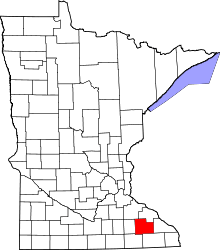Rochester Epidemiology Project
 | |
| Abbreviation | REP |
|---|---|
| Motto | Improving health globally by studying health locally. |
| Formation | 1966 |
| Type | Community-based health research project |
| Legal status | NIH-funded project |
| Purpose | Research |
| Location |
|
Region served |
|
Principal Investigators |
|
| Website |
rochesterproject |
The Rochester Epidemiology Project (REP) is a unique records-linkage research infrastructure that has existed since 1966, and allows for population-based medical research in Olmsted County, Minnesota. The project has been continually funded by the National Institutes of Health since 1966. Specifically, the REP links together medical diagnosis and procedure information across all medical providers in the county. The project is a collaboration between Olmsted Medical Center, the Mayo Clinic, and Rochester Family Medicine Clinic.
History
The REP was originally funded by the National Institute of General Medical Sciences in 1966 under the direction of Dr. Leonard T. Kurland,[1] a neurologist who started his career at the NIH and moved to Olmsted County, Minnesota when he realized the great benefit to medical research that a population-based record linkage system could have.[2][3][4][5] Dr. Kurland considered Olmsted County an optimal location for such a population-based research infrastructure because the county is relatively isolated from other metropolitan centers, almost all medical care is received within the county, and all medical specialties are available to county residents.[4] More recently, the study funding source changed to the National Institute of Arthritis and Musculoskeletal and Skin Diseases, and as of July 2010 the REP is funded by the National Institute on Aging.[3] In September 2016, the REP celebrated 50 years of continuous NIH funding.[6]
The Population
The REP includes the medical records of all persons who have ever lived in Olmsted County, Minnesota between January 1, 1966 and the present, and who have given permission for their medical information to be used for research.[7] Those persons comprise more than 500,000 unique individuals and more than 6 million person years of follow-up through 2010.[2][8] Historically, the Olmsted County population is less racially diverse than the US as a whole; however, it has been found to be similar to the state of Minnesota and surrounding states (Wisconsin, Iowa, North Dakota, and South Dakota).[9]
Scientific Contributions
The REP has contributed significantly to the understanding of many diseases, including epilepsy,[10] rheumatoid arthritis,[11] osteoporosis,[12] Parkinson's Disease,[13] dementia and Alzheimer's Disease,[14] heart failure,[15] stroke,[16] multiple myeloma,[17] and many others. Since its inception, the REP has supported more than 2,600 peer-reviewed scientific publications spanning almost every field of medicine.[6]
References
- ↑ Whisnant JP; Mulder DW. (2002). "Leonard T. Kurland: 1921-2001.". Annals of Neurology. 51 (5): 663. doi:10.1002/ana.10183. PMID 12112123.
- 1 2 St. Sauver JL; Grossardt BR; Yawn BP; Melton LJ 3rd; Pankratz JJ; Brue SM; Rocca WA. (2012). "Data Resource Profile: The Rochester Epidemiology Project (REP) medical records-linkage system". Int J Epidemiol. 41 (6): 1614–24. doi:10.1093/ije/dys195. PMID 23159830.
- 1 2 Rocca WA; Yawn BP; St Sauver JL; Grossardt BR; Melton LJ. (2012). "History of the Rochester Epidemiology Project: Half a Century of Medical Records Linkage in a US Population.". Mayo Clin Proc. 87 (12): 1202–13. doi:10.1016/j.mayocp.2012.08.012. PMID 23199802.
- 1 2 Melton, LJ III. (1996). "History of the Rochester Epidemiology Project.". Mayo Clin Proc. 71 (3): 266–274. doi:10.1016/S0025-6196(11)63966-9. PMID 8594285.
- ↑ Kurland LT; Molgaard CA. (1981). "The patient record in epidemiology.". Scientific American. 245 (4): 54–63. doi:10.1038/scientificamerican1081-54. PMID 7027437.
- 1 2 Boese, Brett (27 September 2016). "A 'hidden gem' at Mayo celebrates 50 years". PostBulletin. Retrieved 3 October 2016.
- ↑ St. Sauver JL; Grossardt BR; Yawn BP; Melton LJ 3rd; Rocca WA. (2011). "Use of a medical records linkage system to enumerate a dynamic population over time: the Rochester epidemiology project.". Am J Epidemiol. 173 (9): 1059–68. doi:10.1093/aje/kwq482. PMC 3105274
 . PMID 21430193.
. PMID 21430193. - ↑ St. Sauver JL; Grossardt BR; Leibson CL; Yawn BP; Melton LJ 3rd; Rocca WA. (2012). "Generalizability of epidemiological findings and public health decisions: an illustration from the Rochester Epidemiology Project". Mayo Clin Proc. 87 (2): 151–60. doi:10.1016/j.mayocp.2011.11.009. PMC 3538404
 . PMID 22305027.
. PMID 22305027. - ↑ Annegers, JF.; Rocca WA; Hauser WA. (1996). "Causes of epilepsy: Contributions of the Rochester Epidemiology Project". Mayo Clin Proc. 71 (6): 570–5. doi:10.1016/S0025-6196(11)64114-1. PMID 8642886.
- ↑ Maradit Kremers, H.; Crowson CS; Gabriel SE. (2004). "Rochester Epidemiology Project: A unique resource for research in the rheumatic diseases.". Rheum Dis Clin N Am. 30 (4): 819–34. doi:10.1016/j.rdc.2004.07.010. PMID 15488695.
- ↑ Richelson, LS.; Wahner HW; Melton LJ III; Riggs BL. (1984). "Relative contributions of aging and estrogen deficiency to postmenopausal bone loss.". N Engl J Med. 311 (20): 1273–5. doi:10.1056/NEJM198411153112002. PMID 6493283.
- ↑ Bower, JH.; Maraganore DM; McDonnell SK; Rocca WA. (1999). "Incidence and distribution of parkinsonism in Olmsted County, Minnesota, 1976-1990.". Neurology. 52 (6): 1214–20. doi:10.1212/wnl.52.6.1214. PMID 10214746.
- ↑ Schoenberg, BS; Kokmen E; Okazaki H. (1987). "Alzheimer's disease and other dementing illnesses in a defined United States population: Incidence rates and clinical features.". Annals of Neurology. 22 (6): 724–9. doi:10.1002/ana.410220608. PMID 3435081.
- ↑ Hellermann, JP; Goraya TY; Jacobsen SJ; Weston SA; Reeder GS; Gersh BJ; Redfield MM; Rodeheffer RJ; Yawn BP; Roger VL. (2003). "Incidence of heart failure after myocardial infarction: Is it changing over time?". Am J Epidemiol. 157 (12): 1101–7. doi:10.1093/aje/kwg078. PMID 12796046.
- ↑ Whisnant, JP; O'Fallon WM; Sicks J; Ingall T. (1993). "Stroke incidence with hypertension and ischemic heart disease in Rochester, Minnesota.". Annals of Epidemiology. 3 (5): 480–2. doi:10.1016/1047-2797(93)90100-i. PMID 8167822.
- ↑ Kyle, RA; Therneau TM; Rajkumar SV; Larson DR; Plevak MF; Melton LJ III (2004). "Incidence of multiple myeloma in Olmsted County, Minnesota: Trend over 6 decades.". Cancer. 101 (11): 2667–74. doi:10.1002/cncr.20652. PMID 15481060.
